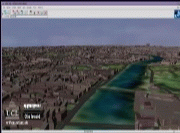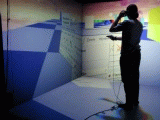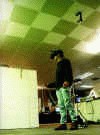| ... |
The UCL Vision for EQUATOR
    As digital technologies have matured, they have begun to move beyond the
workplace to other domains of our everyday lives: our homes, neighbourhoods, what
we wear and carry with us. The convergence of interactive digital systems,
networks and mobile devices is transforming the ways that we carry out our
everyday life, e.g. how we entertain ourselves, work, shop and converse (see
Figure 1). We increasingly undertake everyday activities and share our lives with
others in both physical environments and digital spaces, continually stepping
over the border between the two. Many actions in our physical environment have
analogues and effects in digital space, and vice versa. It becomes possible to
link geographically distant people, to access information from remote locations,
and to draw from the recorded past to support ongoing activity and plans for the
future. For example, a car driver checks her location, plan, and route
recommendations on a dashboard display, circumventing a traffic jam while hardly
aware of the system of computers and satellites in the background. A traveller
swipes a card at an airport turnstile, unconcerned by the hidden flurry of checks
and calculations that let them board the flight. In both these cases, the boundary of the physical and the digital is easy and effortless to cross, not requiring the person to control the technology or handle the boundary.
As digital technologies have matured, they have begun to move beyond the
workplace to other domains of our everyday lives: our homes, neighbourhoods, what
we wear and carry with us. The convergence of interactive digital systems,
networks and mobile devices is transforming the ways that we carry out our
everyday life, e.g. how we entertain ourselves, work, shop and converse (see
Figure 1). We increasingly undertake everyday activities and share our lives with
others in both physical environments and digital spaces, continually stepping
over the border between the two. Many actions in our physical environment have
analogues and effects in digital space, and vice versa. It becomes possible to
link geographically distant people, to access information from remote locations,
and to draw from the recorded past to support ongoing activity and plans for the
future. For example, a car driver checks her location, plan, and route
recommendations on a dashboard display, circumventing a traffic jam while hardly
aware of the system of computers and satellites in the background. A traveller
swipes a card at an airport turnstile, unconcerned by the hidden flurry of checks
and calculations that let them board the flight. In both these cases, the boundary of the physical and the digital is easy and effortless to cross, not requiring the person to control the technology or handle the boundary.
    Despite these ongoing developments, there are still many everyday activities where the boundary between physical environments and digital space is often over-complex and poorly designed. For example, many people are frustrated with the digital
information found in public kiosks when trying to find out about what to do in a
strange city. The physical technology can be cumbersome and awkward to use whilst
the online information is often hard to navigate through to find things out. In
contrast, our vision is to allow people to pass between the physical and the
virtual so readily that the boundary becomes just a line on a map, rather than a
obstacle to their activities, goals and desires. The physical and the digital need to be seen as distinct but interdependent aspects of our everyday world, rather
than disjoint and independent spheres of activity. Creating such a seamless
integration, however, is difficult. It requires long term research into new models of interaction, new interface and distribution technologies, new applications and
new methods. It also requires a shift in our thinking about research, towards
using and developing theories, practices and techniques that are
interdisciplinary.
Despite these ongoing developments, there are still many everyday activities where the boundary between physical environments and digital space is often over-complex and poorly designed. For example, many people are frustrated with the digital
information found in public kiosks when trying to find out about what to do in a
strange city. The physical technology can be cumbersome and awkward to use whilst
the online information is often hard to navigate through to find things out. In
contrast, our vision is to allow people to pass between the physical and the
virtual so readily that the boundary becomes just a line on a map, rather than a
obstacle to their activities, goals and desires. The physical and the digital need to be seen as distinct but interdependent aspects of our everyday world, rather
than disjoint and independent spheres of activity. Creating such a seamless
integration, however, is difficult. It requires long term research into new models of interaction, new interface and distribution technologies, new applications and
new methods. It also requires a shift in our thinking about research, towards
using and developing theories, practices and techniques that are
interdisciplinary.
 The EQUATOR Experience Projects
The EQUATOR Experience Projects
 The EQUATOR Research Challenges
The EQUATOR Research Challenges
|
... |









